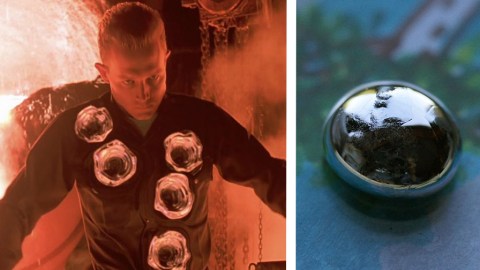Programmable liquid metal could bring the villain from Terminator 2 to life

U.K. researchers have developed a liquid metal that can move and even form 2D shapes. Remember the T-1000 from Terminator 2, one of the most badass villains ever to grace the big screen? It could someday walk the Earth. Not presently though. The U.K. model can’t make 3D shapes, yet. Such technology, however, is poised to revolutionize certain industries.
Researchers at the University of Sussex and Swansea University, both in the U.K., developed this programmable liquid metal. These scientists were able to form it into a variety of shapes including several letters of the alphabet and a heart. So how does it work? Using electrical fields controlled by a computer, scientists were able to shape the liquid or make it move. Yutaka Tokuda is a research associate who worked on the project. He said in a press release:
This is a new class of programmable materials in a liquid state which can dynamically transform from a simple droplet shape to many other complex geometry in a controllable manner. While this work is in its early stages, the compelling evidence of detailed 2D control of liquid metals excites us to explore more potential applications in computer graphics, smart electronics, soft robotics and flexible displays. The electric fields used to shape the liquid are created by a computer, meaning that the position and shape of the liquid metal can be programmed and controlled dynamically.
Prof. Sriram Subramanian, head of the INTERACT Lab at the University of Sussex, was the senior author of this study. He said in a press release that this technology is extremely promising. The liquid metal robot has unique properties, according to the professor, including “voltage-controlled surface tension, high liquid-state conductivity and liquid-solid phase transition at room temperature.”
He added, “One of the long-term visions of us and many other researchers is to change the physical shape, appearance and functionality of any object through digital control to create intelligent, dexterous and useful objects that exceed the functionality of any current display or robot.”
This isn’t the only team working on controlling “electric blood” or liquid metal. IBM has been developing it through their REPCOOL project, since 2013. REPCOOL stands for redox flow electrochemistry for power delivery and cooling. It’s a project that seeks to model a computer after the human brain. Here, synthetic capillaries would bring the electrical blood to cool the computer and deliver energy to it.
Dr. Bruno Michel at IBM Research told Interesting Engineering, “Compared to today’s top computers… the human brain is roughly 10,000 times denser and 10,000 times more energy-efficient.” He added, “The research team believes that their approach could reduce the size of a computer with a performance of 1 petaflop/s from the dimensions of a school classroom to that of an average PC, or in other words to a volume of about 10 liters (2.4 gallons).” A working model isn’t expected to be ready until 2030.
Researchers in the Soft Machines Lab at Carnegie Mellon University have also developed a liquid metal prototype, which they believe will replace transistors. They’ll form liquid transistors, which will be both versatile and self-repairing. The alloy is comprised of a combination of indium and gallium.
To see the liquid robot from the U.K., click here:





